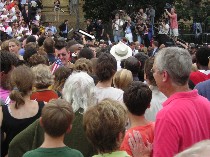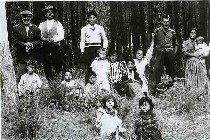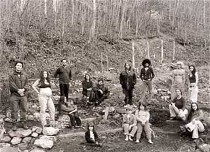 I returned today after yesterday’s political rally for John Kerry in front of the Art Museum (oy, it was so hot there). The water bottles were cleaned up, the political banners removed (left, the rally crowd and Kerry with arrow pointing to his white head of hair).
I returned today after yesterday’s political rally for John Kerry in front of the Art Museum (oy, it was so hot there). The water bottles were cleaned up, the political banners removed (left, the rally crowd and Kerry with arrow pointing to his white head of hair).Inside, I stopped briefly at the Jacques Lipschitz show out of a sense of duty. The work felt dusty–a dead end. When was the last time you saw someone create a sculpture that made you think, wow, that was influenced by Lipschitz? The politics, so heartfelt, the imagery borrowed from the ancient Greeks, felt ancient. Some of the work was interesting, but mostly, it felt dated.
On the other hand, I also stopped by the photo tribute to the late Michael E. Hoffman, who had been the photo curator for the museum since the late ’60s. Although some of the work went back in time, it didn’t feel in the least dated. I was struck by how much young photographers working today are still mining this work for inspiration.
 In Irving Penn’s “Gypsy Tribe of 16” (made from a 1963 negative) I saw Justine Kurland’s commune shots (Penn’s photo right, Kurland’s photo “Wind Song,” which is not a part of the show, below left). In Richard Misrach’s “Dead Animals #79” I saw Sally Mann’s dead humans. In Will McBride’s “Ricky in His Sleeping Bag, Smoking”, from 1984, I saw Alec Soth’s “Sleeping by the Mississippi” series.
In Irving Penn’s “Gypsy Tribe of 16” (made from a 1963 negative) I saw Justine Kurland’s commune shots (Penn’s photo right, Kurland’s photo “Wind Song,” which is not a part of the show, below left). In Richard Misrach’s “Dead Animals #79” I saw Sally Mann’s dead humans. In Will McBride’s “Ricky in His Sleeping Bag, Smoking”, from 1984, I saw Alec Soth’s “Sleeping by the Mississippi” series.
The politics of the past in these images also seemed fresh. Susan Meiselas’ “Soldiers Searching Bus Passengers, Northern Highway, El Salvador” (1980), an image of the shadows of soldiers with guns, passengers with hands on head, cast on the flat rock and dirt wall cut into the mountain, brought me right to today’s disturbances around the world.
 Some photos were filled with magical realism; some were Americana or the English equivalent; some were landscapes, the best of them making you see the world around you with new eyes.
Some photos were filled with magical realism; some were Americana or the English equivalent; some were landscapes, the best of them making you see the world around you with new eyes.
This was an excellent show with nearly 90 pictures. For more on it, see what Roberta wrote here.









